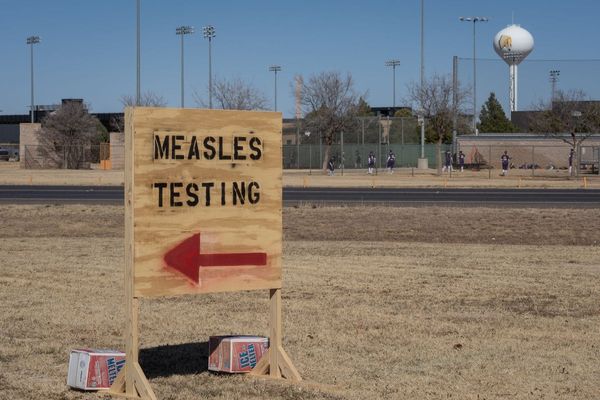
Nearly 100 years ago, north-west Michigan cherry farmers and Traverse City community leaders started a festival to promote the city and their region’s tart cherry crop as a tourist destination.
Now known as the “cherry capital of the world”, Traverse City’s National Cherry Festival draws 500,000 visitors over eight days to this picturesque Lake Michigan beach town to enjoy carnival rides and airshows, and to eat cherries. It also sparked a thriving agrotourism industry amid its rolling hills that now boasts dozens of shops, wineries, U-pick orchards, and farm-to-table restaurants helmed by James Beard-award-winning chefs.
All the sunshine, hustle and bustle, however, can’t hide an ugly truth: Michigan’s cherry farmers are in dire straits. Climate change, development, labor shortages and tariffs threaten their ability to grow one of Michigan’s signature crops.
Cherries are the epitome of Michigan’s “specialty crop” production that also includes apples, asparagus and other fruit and vegetable crops. Altogether, the total economic impact of Michigan’s specialty crop industry is $6.3bn, according to Michigan State University.
The state overall grows 75% of the US’s tart cherries, most coming from multigenerational family farmers in the unique microclimate along Lake Michigan’s eastern shore, with the bulk of production in the north-west.
“Cherries are a volatile crop all of the time. But over the last 10 to 15 years, we’ve really seen more of those ups and downs,” says Emily Miezio, a second-generation farmer and part-owner of Cherry Bay Orchards in Leelanau county.
Climate change makes early spring hazardous for northern Michigan fruit farmers. Lake Michigan’s sandy soils and cool breezes are ideal for cherry production, but warmer temperatures cause trees to break dormancy earlier, making them more susceptible to late brief cold spells, such as what happened this year.
A prime example of the weather volatility happened in late April when a cold snap damaged the fruit-producing flower buds. Farmers will start picking cherries in mid-July, and Dr Nikki Rothwell, extension specialist and Northwest Michigan Horticulture Research Center coordinator at MSU, estimates north-west Michigan will harvest 30m pounds, versus 100m last year.
Climate change is causing other adverse weather events. Rothwell says the late-April temperatures weren’t typically cold enough to harm buds, but wind accompanied the cold, which caused unexpected damage since previously scientists didn’t think wind chill harmed trees. A rare hailstorm in June also caused some damage. Rothwell says an unusually dry fall may have left cherry trees susceptible as well.
“It blows my mind a little bit as a scientist because you think you can find answers in the chaos … but I feel like we’re always being thrown curveballs,” she says.
Land prices are rising sharply as wealthier residents move to the area seeking either primary residences or vacation homes, and developers can edge out farmers for prime orchard land, often on top of rolling hills that offer scenic vistas.
Labor issues are also hampering cherry production. The supply chain relies on a mix of local and migrant labor, and there is a shortage of both. Some migrant laborers are hired through the H-2A visa, a temporary work visa for agricultural jobs, and some migrant laborers are undocumented, says Dr David Ortega, a professor at MSU’s department of agricultural, food and resource economics.
Cherrypicking is often done mechanically, but packing and processing relies on human labor. Ortega says producers and other stakeholders have seen how Immigration and Customs Enforcement raids make some workers afraid to show up because of deportation fears. Without enough agricultural workers, many of Michigan’s specialty crops could spoil.
Specialty crop farmers rely on shared equipment, facilities and workers, and this interdependency means the loss of one crop has a domino effect. Unlike farmers who grow annual crops such as grains, cherry trees can produce for nearly 30 years and farmers need to continually care for trees even when they lose money. Estimates by MSU show the land, operational and harvest costs for productive farmers is about 44 cents a pound, but last year the average farmer received 11 cents a pound for cherries.
Tariffs are a double-edged sword for Michigan farmers, Ortega says. Farmers will pay more for imported fertilizer or equipment, and tariff uncertainty makes it harder to plan. However, farmers may see a slight benefit from tariffs if it raises the costs of imported cherries, as the food industry relies on imports to meet year-round consumer demand, he adds.
Local retailers also work with farmers. Bob Sutherland, founder of Cherry Republic, a regional, 37-year-old cherry-focused snack and gift retailer, works exclusively with local farmers and other suppliers to promote the area’s bounty. The firm’s longstanding relationships means Cherry Republic can acquire enough local cherries to ensure a year-round supply.
Still, the destination-retailer has allowed some cranberries and blueberries as part of their line of more than 200 products out of necessity because of climate change’s unpredictability, he adds.
Michigan’s farmers are facing stiff odds, but Rothwell says despite all the hardships, farmers remain optimistic.
“Every spring they’re like, ‘this is it. This our year. We’re gonna do it.’ They always remain optimistic,” she says.







